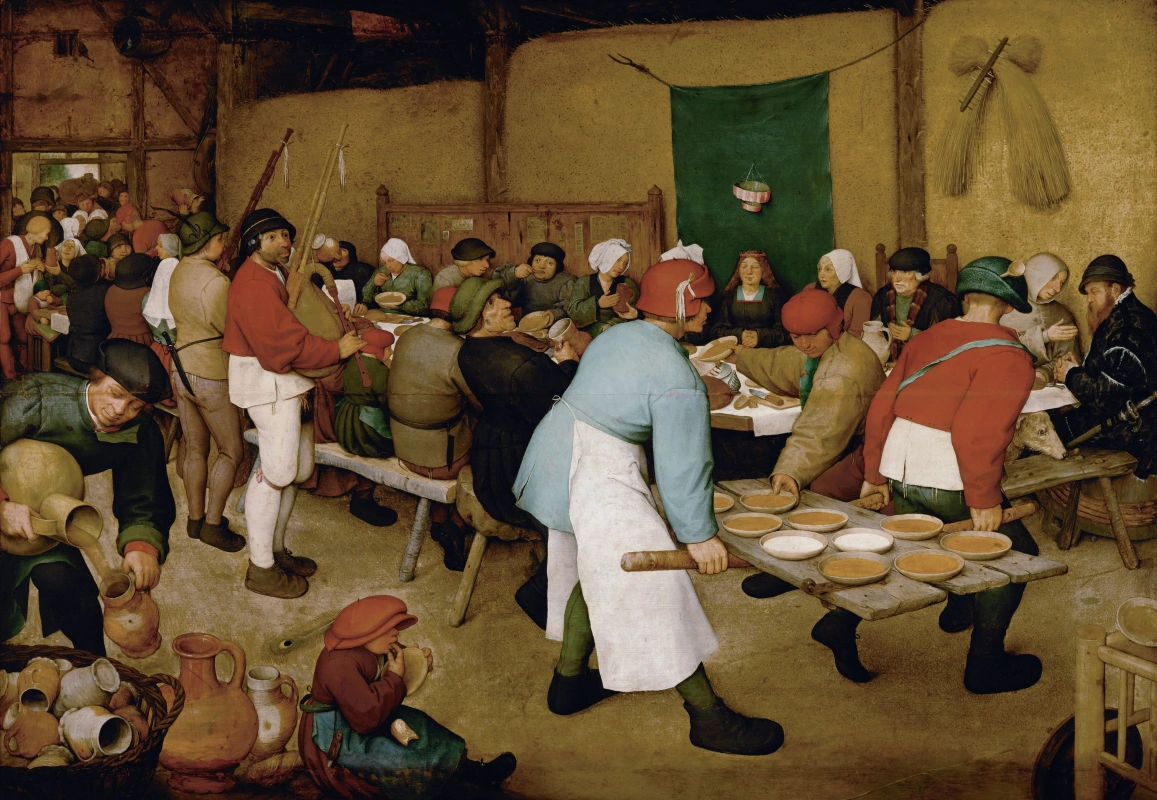log in
Enter site
Login to use Arthive functionality to the maximum
Peasant wedding
Pieter Bruegel The Elder • Peinture, 1568, 114×163 cm


















Descriptif de la toile «Peasant wedding»
Bruegel's biographer Karel van Mander tells us that the artist was very friendly with one of his customers – a merchant named Hans Frankort. And one fun was the friends favorite:"They were on the wedding disguised as peasants and, posing as relatives of either the groom or bride, trays, and gifts. Here Bruegel is a great pleasure to watch these unsophisticated techniques of the peasants in eating, drinking, dancing, jumping, courting women and other amusements he is so funny and beautifully reproduced it in oil, water colors, equally well being able to use both ways. Excellent and with a great knowledge he wrote Kempinski and other places typical clothing of peasants and peasant women, and extremely subtly conveyed their clumsiness in dancing, gait, posture and other movements".
Thanks to these visits, there appeared two remarkable paintings: "Peasant wedding" (Museum of art history, Vienna) and "The peasant dance"or "bride Dance" (Institute of arts, Detroit).
Peasant houses were dark and cramped. They do not contain all. So breugel's peasants play in the spacious barn. The wall is assembled straw. The wooden door is off the hinges and use as a tray. Dishes in the most simple dishes: porridge, jelly. What is surprising: plenty of space, and a lot of clay pots in the lower left corner is left unused, but somewhere out there, in the doorway, the people crowd and creates a stampede. It may sound counterintuitive, unless you know that in the middle of the XVI century the Spanish authorities of the Netherlands official decree forbade peasants to assemble in groups of more than twenty people, fearing conspiracies and riots.
Rarely Bruegel individualisieren their characters. As a rule, they it is difficult to quantify, numerous and faceless. "Peasant wedding" in this sense is an exception. Detailed written inspired face Butler, a surprised and red-nosed musician, interested in guest profile in black. Funny kid freaking out in the hat in the foreground, absorbing the bread. And on the extreme right of the bearded man conversing with a monk, some say a self-portrait of Bruegel.
But where were the celebrants? In the picture we can see only the bride. Like all other women, she dressed in the dark. Only the guests in festive white bonnets, and the bride, in the tradition of the time – long hair and a thin crown on his head. Bride folded my hands and closed my eyes. What is she waiting for?
The groom tried to recognize the young man in a red cap, handing out plates, as well as the man in black, pours the wine. All versions do not look convincing. The absence of the bridegroom enables some interpreters to claim that the picture has religious overtones, where the bride is the Church waiting for her groom – Christ, who "shall come," that is, will come later, when the time is right.
Author: Anna Yesterday
Thanks to these visits, there appeared two remarkable paintings: "Peasant wedding" (Museum of art history, Vienna) and "The peasant dance"or "bride Dance" (Institute of arts, Detroit).
Peasant houses were dark and cramped. They do not contain all. So breugel's peasants play in the spacious barn. The wall is assembled straw. The wooden door is off the hinges and use as a tray. Dishes in the most simple dishes: porridge, jelly. What is surprising: plenty of space, and a lot of clay pots in the lower left corner is left unused, but somewhere out there, in the doorway, the people crowd and creates a stampede. It may sound counterintuitive, unless you know that in the middle of the XVI century the Spanish authorities of the Netherlands official decree forbade peasants to assemble in groups of more than twenty people, fearing conspiracies and riots.
Rarely Bruegel individualisieren their characters. As a rule, they it is difficult to quantify, numerous and faceless. "Peasant wedding" in this sense is an exception. Detailed written inspired face Butler, a surprised and red-nosed musician, interested in guest profile in black. Funny kid freaking out in the hat in the foreground, absorbing the bread. And on the extreme right of the bearded man conversing with a monk, some say a self-portrait of Bruegel.
But where were the celebrants? In the picture we can see only the bride. Like all other women, she dressed in the dark. Only the guests in festive white bonnets, and the bride, in the tradition of the time – long hair and a thin crown on his head. Bride folded my hands and closed my eyes. What is she waiting for?
The groom tried to recognize the young man in a red cap, handing out plates, as well as the man in black, pours the wine. All versions do not look convincing. The absence of the bridegroom enables some interpreters to claim that the picture has religious overtones, where the bride is the Church waiting for her groom – Christ, who "shall come," that is, will come later, when the time is right.
Author: Anna Yesterday





